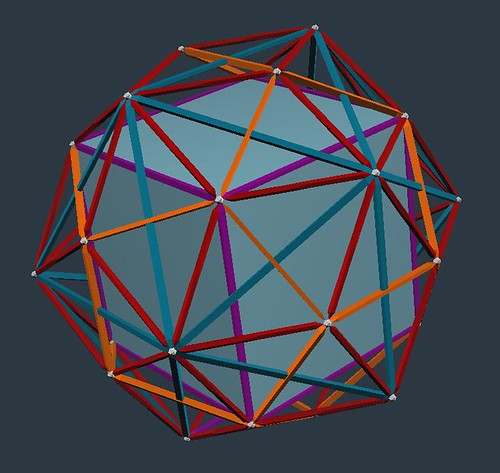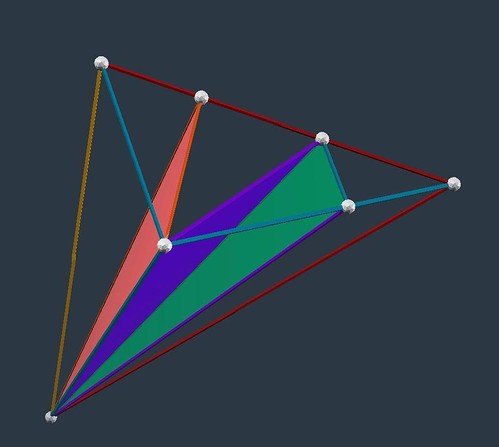Scope relates to terminology. In computer programming, we're always looking to prevent "name collisions" which is like when everyone uses the term "vector" but defines it in different ways, ditto "quaternion" or "duckrabbit". The Java language took your Internet domain and flipped it around, drilling down to some unique path, at the end of which your "vector" might append -- just yours. Like I might have net.4dsolutions.quadrays.vector -- in Clojure.
Koski and I were yakking on Verizon tonight, mostly about terminology. I think it's fine to divide the RT's E-mod into "Fe Fi Fo Fum", reminiscent of the Jack and the Beanstalk story sure, but also of "Do Re Me Fa".
Let me unpack that a bit. RT = Rhombic Triacontahedron (raise your hand if you thought Russia Today) and in having 30 rhombic (diamond) faces, each criss-crossed by face diagonals, it begets 120 of what we call E-mods in Synergetics, though the latter term relates to an RT of specific radius: same as that of a unit sphere.
The RT arises from combining two Platonics, dual to one another, the Icosahedron and Pentagonal Dodecahedron. Their edges provide the criss-crossing long and short diagonals respectively, of the 30 diamond faces.
The Icosahedron, when spun, around opposite vertexes, edge middles, face centers, generates a network of 31 great circles likewise consisting of 120 LCD (lowest common denominator) triangles, which may be superimposed on the RT, effectively slicing each E-mod into four sub-modules. These are what David is naming the Fe, Fi, Fo and Fum (alternatively: Fee, Fie, Foe, Fum).
The Fi-mod, for example, has the volume of the containing E-mod with edges scaled down by precisely 1/Phi (0.618...), meaning its volume, a 3rd power of edge-length, has (1/Phi)(1/Phi)(1/Phi) the E-mod's volume. E weighs in as a tad greater than 1/24th (of the uni-volumed tetrahedron).
What we were discussing tonight is how one of the radii of the Fi is the S-factor, 1.08..., defined originally as the volumetric ratio between the S- and E-mods, or equivalently the ratio twixt the volume 20 cuboctahedron and its partner in Jitterbug, the volume ~18.51 Icosahedron.
Cubocta / Icosa == S / E == S-factor (S).
One of the Fi-mods radii is S.
We need to distinguish S from S3, the latter being the volumes ratio of the cube of edges R (= unit sphere radius) to the tetrahedron of edges D (D = 2R). The former is a bit bigger by 1.06... or so. S3 serves as our conversion constant between two systems of mensuration, the XYZ and IVM.
XYZ is the grid of cubes we're all used to from our math classes. IVM, or "isotropic vector matrix" is the scaffolding (grid) defined by spheres in closest packing, consisting of tetrahedrons and octahedrons of volume ratio 1:4. How we juxtapose these two is by convention and intelligent design.
Another math fact: the cuboctahedron of volume 20 times S3 gives the volume of the so-called "SuperRT" the RT formed from said ~18.51 volume Icosahedron and its dual. The SuperRT derives from the aforementioned unit radius RT (of 120 E-mods) by scaling all edges up by phi (not fi) i.e. 1.618..., increasing volume by a factor of Phi to the 3rd power.
Such is the terminological world in which Koski and I swim around. It'd be completely a private language were it not for it's tightly syncing with what's long been published and out there i.e. Synergetics itself, by the genius R. Buckminster Fuller.
The so-called E-mod is a part of a family, which includes the A-, B-, T-, E- and S-modules. These are core to the Synergetics "concentric hierarchy", built around a duo-tet cube of volume 3. A-mods alone build the unit volume tetrahedron, whereas As and Bs build the octahedron of volume 4. Both A- and B-mod, like the T-mod, have volume 1/24. They all have handedness (left and right versions).
For more information, about the S-module especially, my Coffee Shops Network blog.
Koski and I were yakking on Verizon tonight, mostly about terminology. I think it's fine to divide the RT's E-mod into "Fe Fi Fo Fum", reminiscent of the Jack and the Beanstalk story sure, but also of "Do Re Me Fa".
Let me unpack that a bit. RT = Rhombic Triacontahedron (raise your hand if you thought Russia Today) and in having 30 rhombic (diamond) faces, each criss-crossed by face diagonals, it begets 120 of what we call E-mods in Synergetics, though the latter term relates to an RT of specific radius: same as that of a unit sphere.
The RT arises from combining two Platonics, dual to one another, the Icosahedron and Pentagonal Dodecahedron. Their edges provide the criss-crossing long and short diagonals respectively, of the 30 diamond faces.
The Icosahedron, when spun, around opposite vertexes, edge middles, face centers, generates a network of 31 great circles likewise consisting of 120 LCD (lowest common denominator) triangles, which may be superimposed on the RT, effectively slicing each E-mod into four sub-modules. These are what David is naming the Fe, Fi, Fo and Fum (alternatively: Fee, Fie, Foe, Fum).
The Fi-mod, for example, has the volume of the containing E-mod with edges scaled down by precisely 1/Phi (0.618...), meaning its volume, a 3rd power of edge-length, has (1/Phi)(1/Phi)(1/Phi) the E-mod's volume. E weighs in as a tad greater than 1/24th (of the uni-volumed tetrahedron).
What we were discussing tonight is how one of the radii of the Fi is the S-factor, 1.08..., defined originally as the volumetric ratio between the S- and E-mods, or equivalently the ratio twixt the volume 20 cuboctahedron and its partner in Jitterbug, the volume ~18.51 Icosahedron.
Cubocta / Icosa == S / E == S-factor (S).
One of the Fi-mods radii is S.
We need to distinguish S from S3, the latter being the volumes ratio of the cube of edges R (= unit sphere radius) to the tetrahedron of edges D (D = 2R). The former is a bit bigger by 1.06... or so. S3 serves as our conversion constant between two systems of mensuration, the XYZ and IVM.
XYZ is the grid of cubes we're all used to from our math classes. IVM, or "isotropic vector matrix" is the scaffolding (grid) defined by spheres in closest packing, consisting of tetrahedrons and octahedrons of volume ratio 1:4. How we juxtapose these two is by convention and intelligent design.
Another math fact: the cuboctahedron of volume 20 times S3 gives the volume of the so-called "SuperRT" the RT formed from said ~18.51 volume Icosahedron and its dual. The SuperRT derives from the aforementioned unit radius RT (of 120 E-mods) by scaling all edges up by phi (not fi) i.e. 1.618..., increasing volume by a factor of Phi to the 3rd power.
Such is the terminological world in which Koski and I swim around. It'd be completely a private language were it not for it's tightly syncing with what's long been published and out there i.e. Synergetics itself, by the genius R. Buckminster Fuller.
The so-called E-mod is a part of a family, which includes the A-, B-, T-, E- and S-modules. These are core to the Synergetics "concentric hierarchy", built around a duo-tet cube of volume 3. A-mods alone build the unit volume tetrahedron, whereas As and Bs build the octahedron of volume 4. Both A- and B-mod, like the T-mod, have volume 1/24. They all have handedness (left and right versions).
For more information, about the S-module especially, my Coffee Shops Network blog.
E mod (right tetrahedron) with submodules: Fum, Fo, Fi, Fe going left to right


